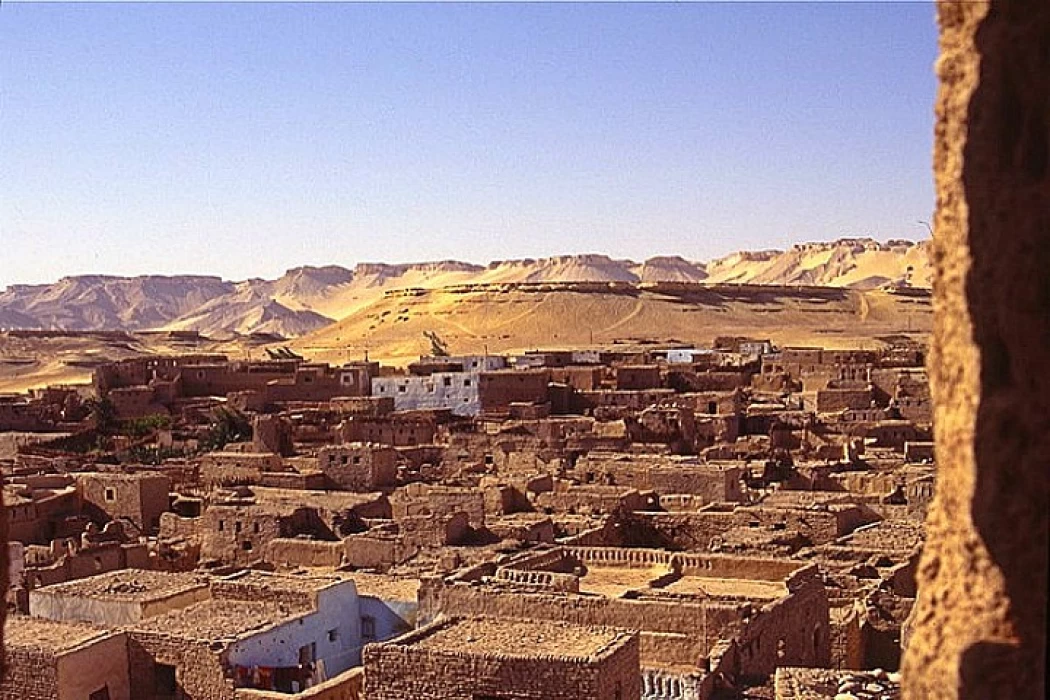
Kharga Oasis
Kharga oasis
These archaeological areas give the site considerable tourist prominence since they are close to the Nile and home to several tourist attractions where visitors can engage in camping or safari activities, as well as view Pharaonic, Roman, and Greek monuments. The low-lying Kharga Oasis is more than 100 kilometers long and is considerably close to the Assiut Governorate and the Western Desert, rendering it unique as a desert place all the more in winter owing to its pleasant and warm climate distinct from all other places of Upper Egypt. The oasis of Kharga had several important quarters that housed antiquities of different eras and other quarters like the Al-Amal quarter, which was the first residential quarter to be built, the museum quarter, and many distinctive villages.
Specializing in agriculture, the village produces a range of crops, including various fruits, vegetables, and dates, and provides for livestock and cattle breeding so that it can safely be called more than a desert tourism governorate; it is also an important agricultural region in Egypt.
Natural and Tourist Attractions
Wells and springs
Many wells and springs in the oasis of Kharga are used for medical tourism, and one of the most famous of them is the Bulaq wells, which are important wells for the treatment of rheumatic diseases. In addition to the Nasser wells in the south of the Kharga Oasis, there is also a Jinnah well.
Temple of Hibis
It is a temple very close to the Kharga Oasis, and this temple is very special as it belongs to different eras, including the Ptolemaic, Roman, Pharaonic, and Persian eras.
This temple was built in the era of the pharaohs, especially in the New Kingdom era, as it was built during the reign of Queen Ires, but it was completed during the reign of Ahmose II, and it was dedicated to the worship of the holy trinity of the ancient Egyptians, which are Amun, his wife Mut and their son Khonsu.
This temple was built in the era of the pharaohs, especially in the New Kingdom era, as it was built during the reign of Queen Ires, but it was completed during the reign of Ahmose II, and it was dedicated to the worship of the holy trinity of the ancient Egyptians, which are Amun, his wife Mut and their son Khonsu.
bhagwat tomb
This sepulcher, adjacent to the Temple of Hibis, takes the shape of a vault and comprises more than 200 church-like tombs; alongside, it is an old church likely to be one of the oldest historical churches in Egypt.
Besides, there is a tomb with an inscription narrating the exodus of the Israelites from Egypt in the time of Prophet Moses, and also tombs having paintings and inscriptions of the Christian era.
Some other locations, like the Al-Labkha area, where there have been remains of a temple and a fort from Roman times, as well as trees, like acacia trees, belong to other periods.
This palace is dated to the second century AD, and this palace has hieroglyphic inscriptions. It contains a temple constructed by Roman Emperor Trajan and dedicated to the goddess Isis and the god Serapis, though the construction continued during the reign of the Ptolemies.
There also exist other temples and a museum, including many collections containing artifacts of more than one era, such as Pharaonic, Roman, or even Coptic treasures.
This is literally the largest and most populous oasis in the western desert. the most developed oasis because of investment by the government in modernizing Egypt into the western desert. It is also centrally placed so that it may be a good starting point for really fabulous safaris into Egypt's desert through the western desert.
Kharga City is quite modern, so you don't really get an oasis-like feeling except in its surrounding villages. where even then you could see the beautiful palm groves and fruit trees.
Kharga becomes a very nice point of departure for magnificent desert safaris in Egypt through the western desert. It is indeed possible to visit from here in and around the city sites of ancient Egyptian and Greco-Roman origins, like the Hibis Temple, and buy great pottery from street traders at the south side of the city (souk), then go out from Qasr—the city of the oasis—to the interesting museum of Kharga's antiques.
The Oasis of Kharga is the largest and most inhabited oasis within the western desert. It's the foremost developed oasis due to the efforts of the government to support the modernization of Egypt’s Western Desert.The city of Kharga is just too fashionable that you just do not associate an oasis-like feeling unless within the close villages. Wherever you continue, you will see the gorgeous palm groves and fruit trees.
Kharga can, therefore, be thought of as the ideal base for exciting Egypt desert safari trips within the western desert. In and around the town, you'll be able to visit ancient Egyptian and Greco-Roman sites, as well as the Hibis Temple, and purchase pottery from native traders within the straightforward market (souk) of the southern part of town. from Qasr, the town of the oasis, before heading to the fascinating museum of Kharga antiques.














